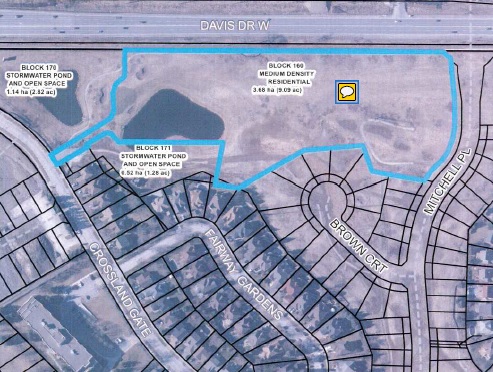Joanne Barnett, the matriarch of Marianneville and developer of Glenway, was at her soothing, reassuring best yesterday (6 March 2017). She was centre stage at the Site Plan meeting at the Town Hall seeking approval for the latest tranche of Townhouses which will soon cover the fairways and putting greens of the now defunct golf course. 
The fairways are now, of course, a distant memory. Today, they are churned up and muddy, much like Paschendale.
Ponds, like bomb craters, dot the landscape where future basements will be.
My spies tell me water continues to be a problem for the developer. I am told it doesn't seem to run away.
But inventive engineers and hydrologists will surely solve the problem and make the water disappear.
Fewer Townhouses
As I am thinking about this, I hear Ms Barnett announce without ceremony that Marianneville is cutting the number of Townhouses in Block 160 (the area where she is seeking site approval) from 153 to 140. There will be 22 buildings with three to eight units in each. Later she repeats:
"There are fewer than the number permitted."
Why is she doing this? What is in it for her?
Ms Barnett explains:
"...although it is zoned for 153 Townhouse units we, because of considerations with respect to buffering and the appropriate amount of green, we are proposing to develop 140 Townhouses."
As a result, the saintly Joanne will be foregoing the profit from 13 Townhouses.
Will she lose sleep over this? I doubt it. After all, Marianneville bought the Glenway lands - the entire shooting match - for $9.9m on 21 January 2010 from the Glenway Country Club (1994) Limited - a sum which Dave Kerwin later described as
"a fantastic buy".
Defining issue
For me, from the outside looking in, Glenway is one of the defining issues of this current Council term – and, indeed, the one before. Hundreds of people have been dramatically affected as their once quiet and leafy neighbourhood is transformed before their eyes.
Unfortunately - as I have repeatedly said - we have never had an honest answer from the Mayor on his role in the debacle. He thanked people at the Glenway "Lessons Learned" meeting for their contributions but, other than that, said nothing himself. It was only afterwards, and in the context of the Clock Tower, Van Bynen revealed his true colours.
"We learned from Glenway that polarity doesn't help anybody."
Translated, this means his preference is always to cut a deal with developers.
Ironies
There are, too, the ironies.
Glenway is being built over at a time when the Town now recognises there will be a shortage of public open space in this part of town - the so-called North West quadrant. In its decision on Glenway, the OMB remarked that by 2010 the Town knew the golf course was available for development but took no steps:
"...to acquire these lands for public open space and public park purposes."
We also wait to see what, if anything, happens to the GO Bus Terminal at Eagle Street. There is - and always has been - a very strong case for co-locating it with the GO Rail station at the Tannery.
However, at the OMB Hearing, much of the argument in favour of the Glenway redevelopment was predicated on the Bus Terminal staying where it is.
Not a shred of evidence
Indeed, the developer's lawyer, Ira Kagan, told the OMB on 27 March 2014:
"There is not a shred of evidence that the Town, Region or GO Transit want to move this bus terminal."
But now that the long awaited Metrolinx/Town “mobility hub study” of the GO Rail station at the Tannery is under way, the Bus Terminal could be on the move too.
If so, much of the rationale for the Glenway development goes with it.
This email address is being protected from spambots. You need JavaScript enabled to view it.
A site plan meeting looks at the design and technical aspects of a proposed development to ensure everything is in compliance with all the relevant rules and regulations.
